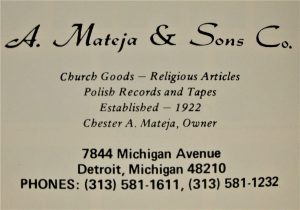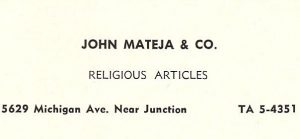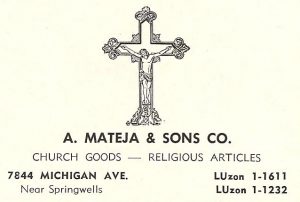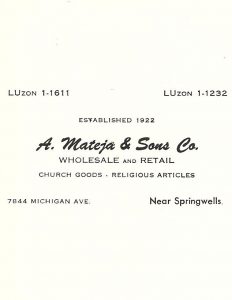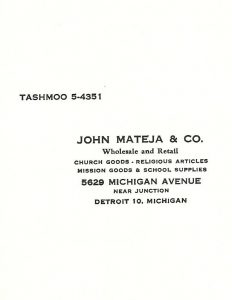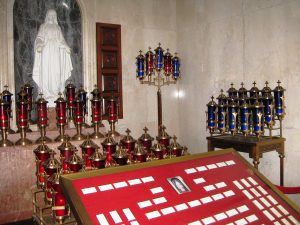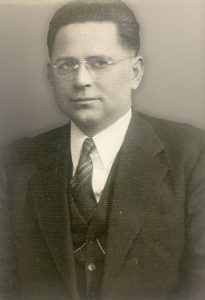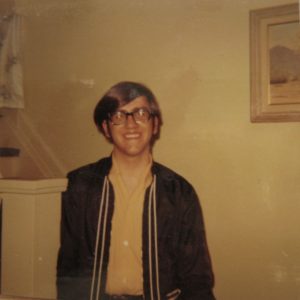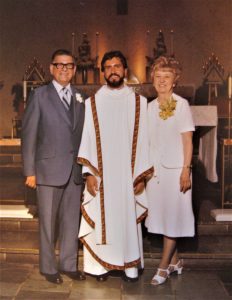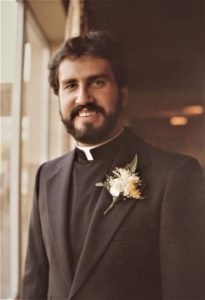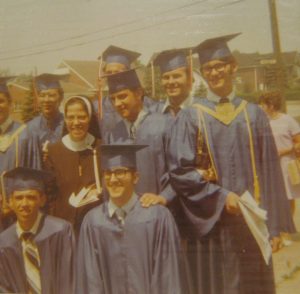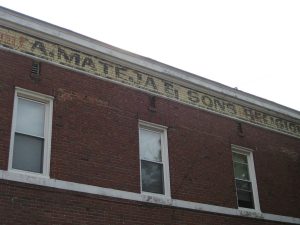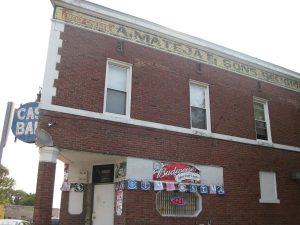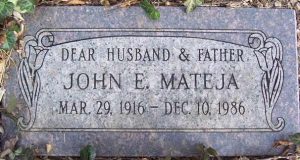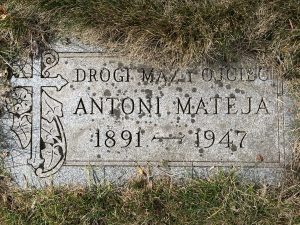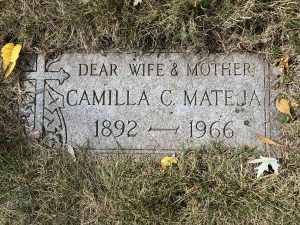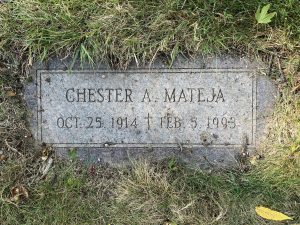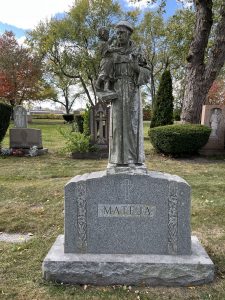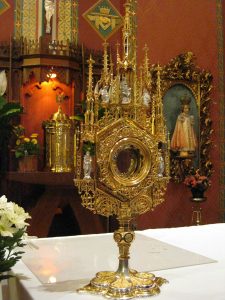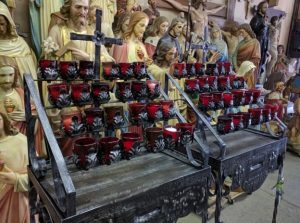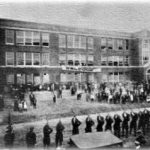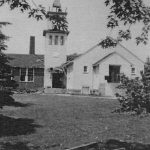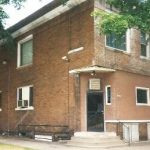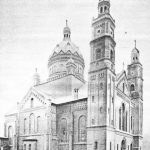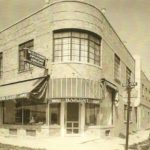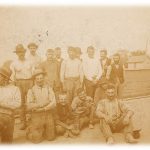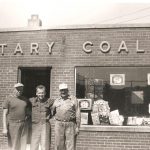A History of A. Mateja & Sons
7844 Michigan Avenue, Detroit 48210
A. Mateja & Sons at 7844 Michigan Avenue, east of Springwells, was arguably the most popular religious supply store on Detroit’s west side during the early to mid-part of the twentieth century.Because of the large prevalence of Polish Catholics in the Michigan Avenue-Junction area at the time and the many Polish Catholic churches, the store had a loyal and consistent customer base.
The store’s founder was Antoni (Anthony) Mateja (June 8, 1891 – October 15, 1947), who established the business in 1922. Anthony married Camilla (also known as Camille or Camelia) Zaborowski (1892 – 1966), and they had three sons, Chester (October 25, 1914 – February 5, 1993), John (March 29, 1916 – December 10, 1986), and Casimir (1918 – 1963). Anthony also had a sister, Mary Waskiewicz. Both Chester and John worked in the store as salesmen.
In addition to their three sons, Anthony and Camille had a daughter named Camille, who may also have worked in the store. Casimir worked in the family business for a while and also served in the 403d Bombardment Squadron, a United States Air Force unit, during World War II. The unit was established in 1940 and activated in 1941. It acted “as a long range reconnaissance squadron, assigned to the GHQ Air Force Northeast Air District” headquartered at Tyndall Air Force Base in Florida.
Anthony and Camille lived in an elegant, multi-family brick home at 10354 South Morrow Circle off Littlefield Boulevard near East Warren Avenue and Wyoming in Dearborn. When he died at age 56, Anthony’s funeral was out of that residence. A funeral Mass was held at St. Hedwig Catholic Church in Detroit.
When Anthony retired or died, Chester and John continued to operate the business. In the 1970s, the two brothers had a falling out, and John left to open his own religious supply store, John Mateja & Company, at 5629 Michigan Avenue, west of Junction, while Chester continued to run A. Mateja & Sons. John persuaded his customers to follow him to his new store, and the two stores competed with one another. However, for decades, A. Mateja & Sons was the preeminent religious supply store in the area.
Chester lived about 20 minutes away from the store, in the vicinity of Littlefield and Wyoming, possibly in the multi-family residence of his parents. Rev. Gary Michalik, President of the West Side Detroit Polish American Historical Society since 2012 and Pastor of St. Colette Catholic Church since 2010, worked for A. Mateja & Sons for six years, from 1973 to 1979. During an interview, he recalled the partnership split between Chester and John. He also shared many fond memories of working with Chester, whose grass he used to cut in the summertime.
“He was a quiet man whose wife [Anne] was homebound,” Fr. Gary stated. “He would leave the store every day at about 11:30 or 11:45 to feed her and come back around 1:30 or 2:00. We always joked that the cat was away and the mice would play.”
A. Mateja was located in a long, narrow, two-story building made of red brick.Dark walnut and glass cabinets were built into the interior walls. On either side of the main entrance there were two display windows, each measuring approximately 7’ or 8’ long. The women employees would often change the window displays to coincide with the season. If a customer wanted something and it was the last item in stock and it happened to be in the window, an employee had to squeeze through a little center door and retrieve it from the window, being careful not to step on something and break it.
On the west side of the building there was a parking lot, a patch of grass, and a statue of the Blessed Mother in an outdoor shrine. On the east side of the building was an old movie theater, which was no longer a functioning theater but which was being used as a reception hall at the time. Next to the theater was the Cas Bar. Chester had the big, colorful advertising on the side and near the top of the Cas Bar building painted onto the brick in approximately 1977.
Fr. Gary, a St. Andrew graduate, began working at Mateja during the summer of 1973, a couple of years after graduating from high school in 1971. He learned of the job opening through a high school classmate, Cynthia Heyza, whose mother, Margaret, sewed Infant of Prague outfits. Margaret was raised by religious sisters who taught her to sew the very intricate Infant of Prague garments. She hand-sewed sequins and patterns onto the capes. The outfits were sold at A. Mateja & Sons.
When he heard of the job opening, Fr. Gary applied for the position and was hired. He was responsible for delivery of candles, opłatki, and other religious articles to numerous churches throughout the Detroit metropolitan area, as well as purchasing, shipping orders out via UPS, sales, inventory, and restocking of supplies.
“It was a great place to work,” recalled Fr. Gary. His coworkers were great to work with, and they had a lot of fun together. He worked with Mary Cwik, Mary’s sister Helen Brustowicz, Eleanor Stasiak, Virginia Biesiadecki, Cecilia Kobylarz, and Chester Mateja, the owner. The bookkeeper, a Polish woman, worked on Saturdays.
Eleanor Stasiak, who was of Greek descent, would say, jokingly, “Polish people take all the letters of the alphabet, throw them up in the air, and wherever they land, that’s their last name.”
“I lived three blocks from the store, and I could walk to work whenever the weather was nice,” Fr. Gary recalled. “The owner, Chester Mateja, was an excellent boss. He was very flexible with my schedule, which had to be worked around my college schedule and, later, the seminary.” When Fr. Gary enrolled in the seminary, he was able to continue working part-time.
The store opened at 9:00 a.m. and closed at 5:00 p.m. on weekdays and Saturdays, and may have closed a bit earlier on Saturdays. Employees were paid by the hour and always received a Christmas bonus. They were a close-knit group. When Fr. Gary was ordained, the whole staff was invited to his ordination and the banquet that followed.
At lunchtime, the employees usually ate at the store. Sometimes, someone would take orders and bring the food back to the store as a carry-out from Starlite (on Michigan Avenue between 51st and 52nd Streets), Red Barn (on Michigan Avenue and Addison), O.K. Restaurant, McDonalds (both on Michigan Avenue), White Castle, or Burger King (both on Michigan Avenue and Martin).
Fr. Gary recalled a time when his first grade teacher from St. Andrew, Sr. Judith, came into the store. When he was in the first grade, he thought she was a giant, she seemed so big to him. On that particular day, someone said, “Sr. Judith is in the store.” Fr. Gary walked out from the back room of the store and was looking all over for her but he couldn’t see her. Finally, he located her, and she was only 4’ 11” tall.
Customers either went into the store to shop or called orders in by phone. There was no fax machine, and there was no Internet at the time. One of Fr. Gary’s assignments was shipping merchandise.
“Eleanor was on one side, and I was on the other side of the work station,” recollected Fr. Gary. “We kept boxes for shipping. We used a big roll of tape that was made of brown paper. We had to water the glued side and seal the box with that. My job was to seal the boxes and type the address on the typewriter, weigh the box, and stamp it. We kept a log as to where the box was going, along with the address. When the UPS driver came to pick up all the boxes, we gave the UPS driver the log, and he gave us a copy and kept a copy. In addition, a lot went out by U.S. Mail.”
Fr. Gary’s job responsibilities included retail orders, ordering stock, filling orders that were shipped, and waiting on customers. He especially enjoyed working with retail customers.
“The place was loaded with stock,” he remembered. “Everything had a place in the store where you could find the stock. There was a code that was used for pricing. Besides being marked with a [pricing] code, the merchandise was also identified with a location identifier,” Fr. Gary stated. If it was in the basement, there were handmade wooden shelving units where the items were stored. Each unit of shelving had a number and letter attached to it, such as “Bin #F,” “Shelf #4.”
The same was true for items in the cabinets in the back. Each cabinet had a certain number and letter attached to it so that employees knew where to go for stock, such as “Main Floor,” “Work Room,” “Garage,” or “Upstairs.”
In the back room—the work room—there were two massive shelving units that spanned almost from the floor to the ceiling, and the women climbed from shelf to shelf to get the merchandise down.
The items that Fr. Gary delivered most were votive candles. Back then, they were made of glass. They came 12 to a box, and each box contained a multitude of colors of candles. Churches would call in orders for the candles. Chester would organize the billing. Each invoice had a white copy and a yellow copy, which was a carbon copy.
Chester had a van. Fr. Gary’s job was to load the candles into the van, drive them to the churches, and take them out and deliver them when he arrived. East side churches that he delivered to were St. Florian, St. Ladislaus, Our Lady Queen of Apostles, St. Bartholomew (on Outer Drive, west of Ryan), St. Louis the King, St. Albertus, and Sweetest Heart of Mary. West side and Downriver churches included St. Andrew, St. Stephen, St. Barbara, Simon & Jude (on Palmer, east of Wayne Road), St. John Cantius (Delray), and St. Stephen (New Boston). He also delivered to parishes in Jackson, Toledo, and Flint.
Chester also had a 1967 Ford LTD. If the van wasn’t available, Fr. Gary used the car to make the deliveries. He always took time out to say a prayer when he made a delivery to a church. Once, when he was making a delivery to Sweetest Heart of Mary Church on Detroit’s east side, he was driving the LTD. He said his usual prayer before he left the church. He had about four more stops to make when he kept hearing a rattling sound coming from the back of the car. It got progressively louder as he continued the deliveries. When he got back to the store, he told Chester that there was something wrong with the car. Chester had the car inspected, and it was discovered that of the five bolts that held the ties to the axle, four had come off.
When he would go to the churches, it wasn’t the maintenance person, but rather the priest who would let him in. He got to meet a lot of the priests. When he became ordained, many of the priests remembered him. He was known as the “candle priest.”
Fr. Gary also delivered religious goods, especially to schools, when they had a parish mission or on occasions when they would sell religious articles during an event. He recalled, “When items were purchased for an event, we would go back and retrieve items that weren’t sold and bring them back to the store, do an inventory, and charge them back.”
Opłatki came from Poland in a large, wooden crate, and it required a crowbar to open the crate. The crate was also filled with packing straw that looked like spaghetti. They would sell the opłatki just as Mateja still sells them today. Churches ordered them, either with envelopes or without. They were all delivered. A lot of times it was the church organist who sold them. In many churches, beginning in November or December, they were sold to supplement the music program. Fr. Gary delivered those to the churches. They were the easiest to deliver because they were so light.
For First Communions, sisters took orders. For the parishes that were farther out, they ordered through the school. “We sent samples of veils, prayer books, rosaries,” Fr. Gary said. “We went to the schools and they placed an order, and we delivered to the schools, and parents would come and pick them up.”
“Popular were tiny plastic nativity sets for schools for the kids, ornaments at Christmastime, medals,” said Fr. Gary. “Another very popular item was a plastic item that looked like a rocket. You opened the door and Mary was inside. Also, glow-in-the-dark statues.”
They sold Infant of Prague statues, statues of all the saints, and crucifixes. “Back then, there were two statuary types: Columbia and Catholic statuary,” Fr. Gary explained. “They were made of chalk and hand-painted in Italy. Crucifixes were hand-carved wood. Some were silver or gold.”
“There was a display case, and all the statues were in there, and the crucifixes were above them,” said Fr. Gary. “On the wall they had prints of original oil paintings.”
“Holy cards, they had thousands of them,” he said, “as well as all kinds of religious knickknacks. We also delivered palms. They sold and delivered altar candles, which were stored in the basement, as well as votive candles that you put in the little glasses. We had two-hour, six-hour, 10-hour, and 15-hour candles. The holders were made of some kind of metal with fake jewels.”
“They also sold chalices, vestments, and monstrances. Priests would order from catalogs, but some were kept in stock. You had to measure the priests. We had black clerical shirts in all different sizes, short-sleeved and long-sleeved.”
“They carried religious greeting cards, individual and boxed, anniversary, Christmas, Easter, in Polish and English. They gave out calendars in English or Polish.”
In approximately 1976, Chester diversified and started selling polka records, eight-track tapes, and cassette tapes. He would get them shipped in from Chicago and other cities. A record store owner would purchase a certain number of albums from Mateja, and Chester would have Fr. Gary deliver the albums to that store. All the big polka bands knew their records were being sold at Mateja. It was a big market.
Society Director Lawrence A. Choraszewski vividly remembers a time when his mother Helen (nee Surowiec) (June 5, 1927 – February 19, 1994) drove to A. Mateja from their home on Barlum Street to buy a newly released Marion Lush album, I’ll Build You A Home, for his dad, Alphonse (January 28, 1925 – February 26, 1999), who was a big polka enthusiast. I’ll Build You A Home was released on the Dyno Records label (LP No. 1689) by Lush (1931 – May 4, 1993), who was known as the “Golden Voice of Polkas.”
The year was approximately 1969, and Larry was about eight years old. In a conversation, Larry recalled walking into Mateja with his mom and three of his siblings to buy the album on that summer afternoon. “You could smell the myrrh and frankincense,” he said.
After leaving Mateja with four of her young children packed into the family’s sprawling 1963 Oldsmobile, Helen, dressed in one of her sleeveless cotton flowered housedresses, headed to the Village Tub laundromat on Michigan Avenue and Chopin to wash clothes.
Genevieve (“Jean”) (nee Gliwa) Theresa Krzisnik Sage (Sugajski) (August 23, 1921 – March 14, 2008) ran the laundromat. Her sister, Sophie Marzek (November 26, 1918 – June 24, 1999), taught catechism classes at St. Andrew, where the Choraszewski family attended church and where the children took catechism. Jean was a big, redheaded woman who drove a white Lincoln Continental, and the vision of her in her big, white Lincoln luxury car was a colorful sight. As Helen pulled up to the Village Tub, Jean was sitting in her car with the music blaring through the speakers from an eight-track tape.
“Helen, you’ve got to listen to this. It’s the new Marion Lush,” she yelled through the rolled-down window of her Lincoln Continental.
“We just came from Mateja, Mrs. Sage,” Helen shouted over to her above the booming music. And, shoving her bare arm through the window frame of the Oldsmobile and holding up the blue shrink-wrapped LP in her hand, Helen hollered, “We have the album.”
Helen and the kids couldn’t wait to get home and produce the album to Alphonse.
The busiest times at Mateja were spring, First Communions, graduations, Advent, Christmas, Lent, and Easter. It would slow down right after Christmas and pick up for Lent, Mother’s Day, Advent, and Easter. It would pick up again once school started and continue to Christmas. “We always did inventory after Easter,” Fr. Gary remembered. “We had to count every item in the stock and record it.”
Everything was done by hand, and there was a precise code that was used to identify merchandise for purposes of determining price. The code was both alphabetic—using the phrase “POLSKICRAJ”—and numeric—containing numerals 1 through 0—and the code was hand-printed in pencil on little white tags, which were attached to each piece of merchandise. Each tag contained first, the purchase price from the distributor printed in code; second, the wholesale price printed in code; and finally, the retail price printed in code.
If costs went up, the employees had to change the prices on all the labels. It was an ingenious—but extremely labor-intensive—system.
Priests and nuns were given the wholesale price. In addition, employees were charged the wholesale price.
Fr. Gary previously had attended Wayne State University, considering a possible career in teaching, but finished only one quarter there. He eventually returned to college, however, at the University of Detroit. At that time, his work schedule at Mateja was based on his school schedule. He knew that he wanted a career in the church but wasn’t quite sure in what area. During the school year, he worked part-time and went to school full time. On Fridays and Saturdays, he worked at Mateja. He worked full time in the summertime. He continued working at Mateja until the summer of 1979.
A. Mateja was a fun place to work and provided him with spending money.It also acquainted him with items that were used in churches.
Chester Mateja died on February 5, 1993. Approximately six years later, on January 4, 1999, his wife Anne died.
Chester had one son who became a medical doctor in Texas. When Chester died, his son did not wish to continue in the family business. A businessman, Thomas Klopp, who had eight children, bought the business in 1994 and continued to operate the store for a while at its original location on Michigan Avenue and Springwells.
Shortly after the new owners purchased the store, Fr. Gary went into the store and introduced himself. He told the new owners that he used to work there and told them that he was a goldmine of merchandise information. At that time, he explained the pricing code to them. Fr. Gary continues to be one of the store’s most loyal customers.
It was Andrzejewski’s Marian Church Supply of Saginaw, Michigan, that acquired A. Mateja & Sons. Eventually, they relocated the store to Garden City, Michigan. The company was founded in 1902 by Ignatius Andrzejewski of Bay City, Michigan, and was originally named Andrzejewski’s Religious Goods. In 1988, the original company merged with Marian Church Supply to create Andrzejewski’s Marian Church Supply. When the company acquired A. Mateja & Sons in 1994, they became known as A-M Church Supply. In August of 1996, the company added Trinity Church Supply of Cincinnati, Ohio, to their holdings, and most recently acquired G. A. Fuchs Company of Troy, Michigan.
A. Mateja & Sons is now located at 30762 Ford Road in Garden City, where their manager is Greg Klopp.His brother Matthew manages the G. A. Fuchs Company. As of 2022, the original A. Mateja building on Michigan Avenue and Springwells houses an auto supply or auto repair business.
While ministering as a pastor for the past 41 years, Fr. Gary has continued to order religious supplies from A. Mateja. He has come to know the staff very well, and his connection to the company has become a lifelong one.
Fr. Gary’s love of west side Detroit Polish history—and of Polish history and culture in general—has been an invaluable asset in his roles as president of the West Side Detroit Polish American Historical Society and as a member of the Polish American Priests Association. His work at A. Mateja & Sons during his early years helped immensely in rounding out his love of Polish history, heritage, and culture and in his ongoing service to west side Detroit’s Polonia.
A. Mateja & Sons is a name that is synonymous with Detroit’s west side Polonia.Throughout the decades, it served priests, nuns, and other religious and was a place frequented by thousands of west side Detroit Polish Catholics. It was a familiar part of routine Polish Catholic life, traditions, and holidays. It was a visible feature along the Michigan Avenue thoroughfare, and a place that lives on in the memories of those whose roots are still firmly planted in their Detroit Polish neighborhood.
Sources:
- https://en.wikipedia.org/wiki/403d_Bombardment_Squadron
- Choraszewski, Lawrence A. Informal telephone conversation with the author. West Bloomfield, MI: October 5, 2022.
- Grohowski (Mateja), Camille T. Death Notice. In Detroit Free Press. Detroit, MI: Tue., Jan. 11, 2000. Newspapers by Ancestry. https://www.newspapers.com/image/100077260 (Courtesy of Valerie Koselka)
- https://www.ancestry.com/genealogy/records/genevieve-theresa-gliwa-sugajski-sage-krzisnik-24-ds4dnf
- https://www.findagrave.com/memorial/113145888/john-e-mateja
- https://www.findagrave.com/memorial/157471040/genevieve-theresa-krzisnik
- https://www.findagrave.com/memorial/233990859/antoni-mateja
- https://www.manta.com/c/mmds1l1/a-m-church-supply
- https://en.wikipedia.org/wiki/First_Air_Force
- https://en.wikipedia.org/wiki/403d_Bombardment_Squadron
- Klopp, Greg. Informal telephone conversation with the author. West Bloomfield, MI: October 5, 2022.
- Koselka, Valerie. Email to the author. August 25, 2022.
- Michalik, Rev. Gary. Email to the author. August 9, 2022.
- Michalik, Rev. Gary. Email to the author. October 13, 2022.
- Michalik, Rev. Gary. Informal interview with the author. Livonia, MI: August 2, 2022.
Photos:
- Antoni (Anthony) Mateja, founder of A. Mateja & Sons, ca. 1938. From Greg Klopp, courtesy of Camille (Mateja) Atkinson.
- Antoni Mateja grave marker, St. Hedwig Cemetery, Dearborn Heights, Michigan. Photo: Rev. Gary Michalik, October 13, 2022.
- Mateja family grave monument, St. Hedwig Cemetery, Dearborn Heights, Michigan. Photo: Rev. Gary Michalik, October 13, 2022.
- Camilla C. Mateja grave marker, St. Hedwig Cemetery, Dearborn Heights, Michigan. Photo: Rev. Gary Michalik, October 13, 2022.
- Chester A. Mateja grave marker, St. Hedwig Cemetery, Dearborn Heights, Michigan. Photo: Rev. Gary Michalik, October 13, 2022.
- John E. Mateja grave marker, Mount Kelly Cemetery, Dearborn, Michigan. Photo: https://www.findagrave.com/memorial/113145888/john-e-mateja
- Mateja & Sons ad. In “RUBINOWY JUBILEUSZ PAMIĘTNIK – 40-lecia Grupy 170-ej Związku – Polek w Ameryce – W NIEDZIELĘ 5-go PAŹDZIERNIKA, 1952 – DETROIT, MICHIGAN” – RUBY JUBILEE – ZWIĄZEK POLEK W AMERYCE” (40th Anniversary – Group 170 Polish Women’s Alliance of America – Sunday, October 5, 1952 – Program). WSDPAHS archives.
- John Mateja & Co. ad. In “RUBINOWY JUBILEUSZ PAMIĘTNIK – 40-lecia Grupy 170-ej Związku – Polek w Ameryce – W NIEDZIELĘ 5-go PAŹDZIERNIKA, 1952 – DETROIT, MICHIGAN” – RUBY JUBILEE – ZWIĄZEK POLEK W AMERYCE” (40th Anniversary – Group 170 Polish Women’s Alliance of America – Sunday, October 5, 1952 – Program). WSDPAHS archives.
- Mateja & Sons Co. ad. In St. Andrew Saltire Yearbook, 1954. WSDPAHS Archives, courtesy of WSDPAHS member Lorraine Kasper.
- John Mateja & Co. ad. In St. Andrew Saltire Yearbook, 1955. WSDPAHS Archives, courtesy of WSDPAHS member Lorraine Kasper.
- Michalik, Gary, 1970. Collection of Rev. Gary Michalik.
- Michalik, Gary. St. Andrew High School graduation photo with friends, June 13, 1971. Collection of Rev. Gary Michalik
- Mateja & Co. ad featuring records and tapes. In Saint Andrew’s Parish 60th Anniversary 1920 – 1980 Souvenir Pictorial Directory. Collection of Rev. Gary Michalik.
- “A. Mateja & Sons Religious Supply” painted advertisement with a red arrow directing customers around the “Next Corner.” Chester Mateja had the advertisement painted on the end of the building that housed the Cas Bar, 7800 Michigan Avenue at the corner of Casper Street, in approximately 1977. To the west in the same building, going toward Springwells Street, was a former theater, and then A. Mateja & Sons. Photos: Laurie A. Gomulka, June 2012.
- Rev. Gary Michalik with his parents, Joseph and Stella Michalik. First Mass, St. Andrew Catholic Church, Detroit, June 22, 1980. Collection of Rev. Gary Michalik.
- Michalik, Rev. Gary. Ordination day photo. Detroit, MI: June 21, 1980.
- Votive candles at Holy Sepulchre Cemetery Mausoleum, Southfield, MI. Photo by Laurie A. Gomulka, October 26, 2013.
- Vintage votive candles. Source: https://www.usedchurchitems.com/votive-holders.
- Monstrance at Ss. Andrew & Benedict Catholic Church, Detroit. Photo: Laurie A. Gomulka, May 3, 2009.
